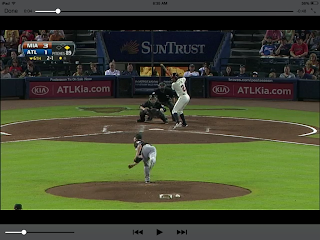I must admit the first 2 blogs were painful to read. But here is to stickin' to it! I am thankful for the 2 of you that read this. :)
So, "infieldflyball" is almost a dirty word to me. I hate them more than strikeouts. I know that you at least put the ball in play and there is a chance it will fall in right after you hear 3 fielders say "I got it". Nonetheless, they are not my favorite. Show me a player that frequently pops the ball up in the infield and I'll show you a player that has problems with consistency because of a swing flaw. Now, I'm not suggesting that when any player pops up...but rather the ones that lead the league in IFFB% (Infield Fly ball). I believe there is a graphical pattern for the players that lead the league in IFFB%. As usual, my intent is to use their perfect swing, or hard hit ball as a reference, not an actual pop-up, any one can say..."see he cut underneath that one." I will also show examples of a players on the other side of the spectrum...Mr. Votto and Shin-Soo Choo.
Here are some examples, you might need to refer to my first blog
"Alien Crop Circles and The Baseball Swing" to get some background. The top 2 lead the league (A. Simmons 17.8%, Jose Bautista 17.6%) in IFFB% and the bottom have the lowest IFFB% (Shin-Soo Choo 0.6%, Joey Votto 0.8%) YIKES!
Going into Launch, or front heel plant, the players have distinct differences. The pop-up kings have a pull with the left shoulder which gives them a little lunge toward the pitcher. Particularly, notice how far the eyes move forward. The top row, get about 4-6" farther ahead. Also, the elbow is used as a timing move for the bottom row, as you can see the bat hardly moves when the elbow moves down to slot. Where as the top row hitters use the back elbow to tug a bit.
Pop up players also tend to share a characteristic that seems to put them more level going into contact. The best work to get on top of the ball. I call the top row, barrel heavy hitters. These hitters tend to hit for power while average suffers a bit. Simmons had a .247 BABIP and Bautista .259 BABIP. The bottom duo have incredible BABIP, .338 and .360 respectively.
The Alien Crop Circles show an abrupt move to work on top of the ball, by the bottom two. These marks are not consistent for each pitch and contact location, but the better hitters only lose their ability to work on top of "pitchers pitches" (low and away) or when completely fooled. Then, and only then will they become barrel heavy. Also, there seems to be a distinct move to get the backside through which helps the bottom row players get on plane.
Bear with me, If these were golfers, we would say the top row are "two plane" golfers, while the bottom row are "one plane". Two plane golfers tend to work "over the top" and pull hook...two plane hitters in baseball tend to pull the ball. One plane hitters typically use the entire field.
Notice Joey "One Plane" Votto here. He uses his backside to hit through the ball. While Simmons uses a hard top hand whip, which is evident by the two red marks.
one plane hitter
two plane hitter
Obviously, both methods are effective and will get you to the show, but it appears one is better for consistency sake given the BABIP. Here is a list of top 10's from highest to lowest % IFFB. Screen capture taken from
Fangraphs. Now, this is not meant to determine best and worst, as there are useful players on both ends for sure :)
highest IFFB%
lowest IFFB%
So pop-ups are not good based on these numbers. BABIP is not the only distinction between the two groups, but the Line Drive % or LD% is glaringly different. So, the 2 plane and 1 plane theory seems to be consistent based on these two lists. Check them out on your own and see. Go to
http://www.hittrackeronline.com/ and look for these players yourself. Look at the front view and pause the video at contact, take a screenshot and compare.
So, does your up and coming prospect share the pop-up kings swing or does he do what the best in this category do? Alien Crop Circles appear to show some graphical trends that I believe should not be pushed aside for the thoughtful baseball scout, coaches as well as club recruiters. I will continue to show how Alien Crop Circles can communicate swing attributes to us now. What if there was a consistent graphical trend for the highest average hitters? I will explore in my next blog, Triple Crown and Other Alien Forces.






















